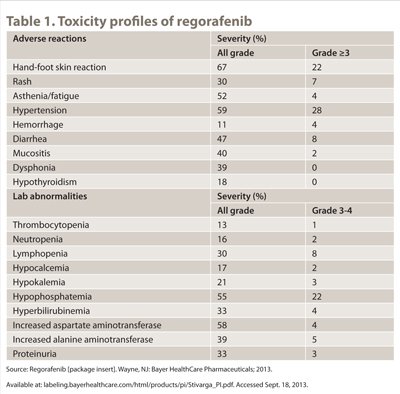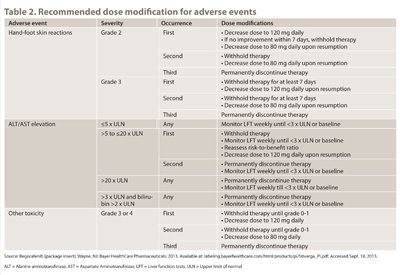Regorafenib renews hope for patients with refractory advanced GIST
Gastrointestinal stromal tumor is the most common sarcoma of the gastrointestinal tract, with an incidence of 5,000 new cases per year in the United States.
Primary gastrointestinal stromal tumor (GIST) frequently arises in the stomach (50%) or small bowel (30%), and it rarely develops in the rectum, colon, esophagus and extra-GI locations.
Most patients have localized disease at diagnosis. However, 10% to 20% of patients present with advanced or metastatic GIST, with common sites of metastases including the abdominoperitoneal cavity and the liver.
Before the advent of tyrosine kinase inhibitors, the diagnosis of advanced GIST signaled poor outcome, with median survival for patients with unresectable or metastatic disease ranging from 10 to 20 months.
Treatment landscape
The treatment landscape for advanced GIST has transformed dramatically since the groundbreaking discovery that gain-of-function mutations of KIT and platelet-derived growth factor receptor alpha (PDGFRA) genes are key pathogenic features in 80% and 10% of GISTs, respectively. These molecular lesions result in ligand-independent, constitutively active transmembrane receptor tyrosine kinases (RTKs), driving the development and progression of GIST.
Identification of activating KIT and PDGFRA mutations has fostered the development of small-molecule inhibitors against KIT and PDGFR RTKs for the treatment of advanced GIST. Imatinib (Gleevec, Novartis), shown to extend OS for patients with advanced disease to nearly 5 years, has remained the standard first-line therapy for advanced GIST since its approval in 2002.
Unfortunately, most patients will eventually relapse, with median time from imatinib initiation to disease progression of 24 months. The predominant mechanism of tumor resistance is the acquisition of secondary mutations in KIT or PDGFRA genes, mostly in the exons encoding the ATP- or drug-binding pocket and kinase activation loop, rendering the TKI unable to bind or inactivate the aberrant kinases.
With smaller-sized molecules capable of bypassing the steric hindrance of gatekeeper mutations, sunitinib (Sutent, Pfizer) has been shown to restore disease control after imatinib failure, generating median PFS of roughly 6 months. Approved in 2006, sunitinib has been the standard second-line therapy for patients with advanced GIST after disease progression on or intolerance to imatinib.
Until recently, there has been no universally accepted third-line treatment option for patients with imatinib- and sunitinib-refractory advanced disease.
Efficacy of regorafenib
Regorafenib (Stivarga, Bayer HealthCare) is a multikinase inhibitor structurally related to sorafenib.
However, regorafenib is a more potent inhibitor of KIT, PDGFR and VEGFR-2 than sorafenib. Its spectrum of activity is also broader than that of sorafenib, encompassing additional kinases involved in oncogenesis and angiogenesis.
Regorafenib originally received FDA approval in 2012 for the management of patients with metastatic colorectal cancer who failed fluoropyrimidine-, oxaliplatin- and irinotecan-based chemotherapy, an anti-VEGF regimen and anti-EGFR therapy. In early 2013, its labeled indications were expanded to include the treatment of patients with advanced GIST previously treated with imatinib and sunitinib.
The GIST-Regorafenib in Progressive Disease (GRID) study — a randomized, placebo-controlled, phase 3 trial — demonstrated the clinical benefit of regorafenib after imatinib and sunitinib failure. In the study, 199 patients with advanced GIST previously treated with imatinib and sunitinib were randomly assigned in a 2:1 ratio to regorafenib 160 mg orally once a day for 21 days of a 28-day cycle or placebo. Upon disease progression, patients in the placebo arm were allowed to crossover to receive open-label regorafenib.
Nearly all patients had disease progression on both imatinib and sunitinib, and half of them had failed three or more anti-GIST therapies.
Median PFS was 4.8 months for the regorafenib arm and 0.9 months for the placebo arm, with the HR for progression of 0.27 (P<.0001) favoring regorafenib. Disease control rate, defined as rate of complete and partial response plus stable disease lasting at least 12 weeks, was 52.6% in the regorafenib arm vs. 9.1% in the placebo group (P<.0001). OS was not significantly different between the two groups but could have been confounded by the crossover effect.
Toxicities
Regorafenib is fairly well tolerated.
In the GRID study, 72% of patients required dose modification or interruption because of adverse events. However, permanent treatment discontinuation occurred in only 6% of the regorafenib-treated population, which was similar to the discontinuation rate of 8% in the placebo-treated group.
The most common side effects associated with regorafenib are hand-foot skin reaction (HFSR), hypertension, diarrhea, fatigue and mucositis (Table 1).
HFSR typically occurs during the first cycle of therapy. Patients and their family should be instructed regarding the onset, signs and symptoms of HFSR to ensure early reporting. They also should be encouraged to exercise preventive measures, such as heavy use of topical emollients and avoidance of friction on hand and feet.

Source: Regorafenib [package insert]. Wayne, NJ: Bayer HealthCare Pharmaceuticals; 2013.
Once developed, HFSR is manageable with treatment interruption, dose modification (Table 2), and symptom support with rest, cool compresses, topical emollients and topical steroids. Oral analgesics should be added for pain and discomfort.
Similar to other multikinase inhibitors, regorafenib frequently causes hypertension, which usually develops within the first cycle. Therefore, patients with pre-existing hypertension should have blood pressure adequately controlled before initiating regorafenib. Blood pressure should be monitored weekly for the first 6 weeks of treatment, then at least every cycle to allow prompt institution of antihypertensives if clinically indicated. Regorafenib therapy should be suspended for severe or uncontrolled hypertension.
Although rare, fatal hepatotoxicity was observed in 0.8% of regorafenib-treated patients in the GRID trial. Assessment of liver function tests (LFT) is essential at baseline and every 2 weeks for the first 2 months of therapy. Regorafenib should be interrupted for high-grade transaminitis (Table 2).

Source: Regorafenib [package insert]. Wayne, NJ: Bayer HealthCare Pharmaceuticals; 2013.
Frequency of LFT monitoring should be increased to at least weekly until improvement to grade 1 or baseline. Then, risk-to-benefit ratio should be re-evaluated to decide whether regorafenib can be resumed at a reduced dose or should be permanently discontinued. Regorafenib also should be permanently discontinued for severe or life-threatening hemorrhage, gastrointestinal perforation or fistula, or reversible posterior leukoencephalopathy syndrome.
Dosing
Regorafenib is dosed at 160 mg orally once a day for 21 days of a 28-day cycle. Regorafenib should be administered with a low-fat breakfast containing less than 30% fat.
Dosage adjustment is not needed for pre-existing mild to moderate hepatic dysfunction (Child-Pugh A or B) or mild renal insufficiency (creatinine clearance ≥60 mL/min). However, the use of regorafenib is not recommended in the presence of severe liver impairment (Child-Pugh C) or moderate to severe renal dysfunction (creatinine clearance <60 mL/min), as an appropriate dose has not been established in those conditions.
Because regorafenib is metabolized via cytochrome P450 (CYP) 3A4 and UGT1A9 enzymes, co-administration with strong CYP3A4 inhibitors or inducers should be avoided.
Conclusion
Regorafenib, approved for the management of patients with advanced GIST who have previously failed imatinib and sunitinib, represents the first success in the effort to meet the urgent need for effective therapy to treat this highly refractory patient population.
Active research is ongoing to define regorafenib’s clinical activity against specific resistant genotypes and to explore its mechanism of action in refractory disease.
References:
Corless C. Nat Rev Cancer. 2011;11:865-878.
Demetri G. Lancet. 2013;381:295-302.
Regorafenib [package insert]. Wayne, NJ: Bayer HealthCare Pharmaceuticals; 2013. Available at: labeling.bayerhealthcare.com/html/products/pi/Stivarga_PI.pdf. Accessed Sept. 18, 2013.
Sirohi B. Expert Rev Anticancer Ther. 2013;13:385-393.
For more information:
Van A. Trinh, PharmD, BCOP, and Jennifer Davis, PharmD, BCOP, are clinical pharmacy specialists in melanoma/sarcoma medical oncology at The University of Texas MD Anderson Cancer Center. They can be reached at Pharmacy Clinical Programs, The University of Texas MD Anderson Cancer Center, Houston, TX 77030.
Disclosure: Trinh and Davis report no relevant financial disclosures.
